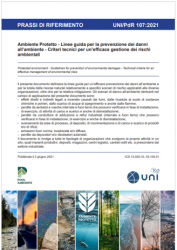ANSI/ASSP Z244.1-2016 (R2020)
| ID 21508 | | Visite: 297 | Documenti normazione ENTI | Permalink: https://www.certifico.com/id/21508 |

ANSI/ASSP Z244.1-2016 (R2020) / The Control Of Hazardous Energy Lockout, Tagout And Alternative Methods
ID 21508 | 14.03.2024 / Preview in allegato
Alcuni utenti precedenti di questo standard potrebbero essere confusi dalla designazione ASSP nel titolo. A causa dell'organizzazione per lo sviluppo di standard accreditata ANSI (SDO), l'American Society of Safety Engineers (ASSE), che ha cambiato nome in American Society of Safety Professionals (ASSP), tutti gli standard ASSP recentemente revisionati e riaffermati ora portano la nuova designazione standard nei loro titoli.
Pertanto, il documento ANSI/ASSE Z244.1-2016 è identico al riaffermato ANSI/ASSP Z244.1-2016 (R2020).
This standard covers machines, equipment and processes in which the unexpected energization or start-up of the machines or equipment, release of stored energy or the actions of persons could result in harm.
Introduction
This standard provides guidance regarding:
- responsibilities of the principal parties involved in hazardous energy control (clause 4);
- design issues that influence the effective application of control methodology (clause 5);
- hazardous energy control program elements necessary for employee protection (clause 6);
- communication and training requirements for involved personnel (clause 6.4);
- hazardous energy program review to ensure its effectiveness (clause 6.5);
- hazardous energy control methods (clause 7);
- alternative methods development for tasks where traditional lockout or tagout prohibits the completion of those tasks (clause 8); and
- special applications where typical methods of hazardous energy control are inappropriate or not practicable (clause 8.4).
The standard provides for decision-making flexibility regarding hazardous energy control methodology. Alternative methods, when used, are based upon risk assessment and application of the classic hazard control hierarchy (clause 8.1.2). However, lockout continues to be emphasized as the primary hazardous energy control method.
1. Scope and Purpose
1.1 Scope
This standard covers machines, equipment and processes in which the unexpected energization or start-up of the machines or equipment, release of stored energy or the actions of persons could result in harm.
This standard establishes requirements for the control of hazardous energy associated with machines, equipment or processes that could cause harm to personnel. The standard specifies the use of lockout (primary method), tagout or alternative methods to control hazardous energy associated with machines, equipment or processes that could cause harm to personnel.
This standard applies to activities such as erecting, installing, constructing, repairing, adjusting, inspecting, unjamming, set up, testing, troubleshooting, cleaning, dismantling, servicing and maintaining machines, equipment or processes.
NOTE: Different organizations characterize the above tasks as servicing, maintenance or operations. Each organization should evaluate how best to control hazardous energy for tasks that are performed.
This standard does not apply to work on cord and plug connected electric equipment for which electricity is the single source of energy; is solely controlled by the unplugging of the equipment from the energy source; and by the plug being under the exclusive control of the person.
This standard does not apply to hot tap operations involving transmission and distribution systems for substances such as gas, steam, water or petroleum products when they are performed on pressurized pipelines.
This standard does not apply to standard passenger vehicles, personal pleasure boats, private aircraft or recreational/sport type vehicles.
1.2 Purpose
The purpose of this standard is to establish requirements that protect personnel where harm can occur as a result of the unexpected release of hazardous energy.
This document is a performance standard and, as such, is not intended to limit or restrict the use of other existing specific standards, procedures or regulations that meet the performance objectives defined in this standard and provide an acceptable level of personal protection from exposure to hazardous energy.
Deviations from the requirements of this standard shall be based on a documented risk assessment.
1.3 Application Exceptions
The presence of an energy source alone does not by itself warrant the need for energy control.
The risk assessment process shall determine which energy sources are considered hazardous for each task.
Energy sources that do not present a hazard, or exposure to the hazard, do not require control of hazardous energies or alternative methods.
...
add
Collegati
ANSI ASSE Z244.1 Ed. 2016
Procedura LOTO Disciplina | Format procedura
Procedura manutenzione LOTO (Lockout/Tagout): modello editabile con immagini
D.Lgs. 81/2008 Testo Unico Salute e Sicurezza Lavoro
Procedura LOTO Disciplina | Format procedura
| Descrizione | Livello | Dimensione | Downloads | |
|---|---|---|---|---|
| ANSI ASSP Z244.1-2016 (R2020) preview.pdf |
935 kB | 0 |









































